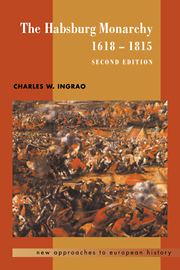Book contents
- Frontmatter
- Contents
- List of maps
- Genealogical tables
- Preface
- 1 The distinctiveness of Austrian history
- 2 The Thirty Years' War (1618–1648)
- 3 Facing east: Hungary and the Turks (1648–1699)
- 4 Facing west: the second Habsburg empire (1700–1740)
- 5 The Prussian challenge: war and government reform (1740–1763)
- 6 Discovering the people: the triumph of cameralism and enlightened absolutism (1765–1792)
- 7 The age of revolution (1789–1815)
- 8 Decline or disaggregation?
- Bibliography
- Index
- More titles in the NEW APPROACHES TO EUROPEAN HISTORY series
8 - Decline or disaggregation?
- Frontmatter
- Contents
- List of maps
- Genealogical tables
- Preface
- 1 The distinctiveness of Austrian history
- 2 The Thirty Years' War (1618–1648)
- 3 Facing east: Hungary and the Turks (1648–1699)
- 4 Facing west: the second Habsburg empire (1700–1740)
- 5 The Prussian challenge: war and government reform (1740–1763)
- 6 Discovering the people: the triumph of cameralism and enlightened absolutism (1765–1792)
- 7 The age of revolution (1789–1815)
- 8 Decline or disaggregation?
- Bibliography
- Index
- More titles in the NEW APPROACHES TO EUROPEAN HISTORY series
Summary
Francis surely merits the criticism he has received. But he also deserves to be evaluated in a broader historical context that distinguishes between the achievements of the first half of his reign and the inertia of the second. Almost without exception, the early modern Habsburgs had achieved their greatest successes in the process of addressing major security crises that they had inherited from their predecessors. And more often than not those crises came in the person of foreign adversaries. In restructuring and reorienting the monarchy the Emperors Ferdinand were inspired less by divine inspiration than by the successive gauntlets thrown down by the Winter King, Gustavus Adolphus and Cardinal Richelieu. The massive territorial gains of Leopold I and his sons owed more to the miscalculations of Kara Mustafa and Louis XIV than to the tactical genius of Prince Eugene. And it was the ruthless Frederick the Great who obliged Maria Theresa and her sons to abandon the Baroque world for the secular rationalism of the cameralists and philosophes; if the “great empress” was unique in launching a second Theresian reform period in the last half of her reign, it was because she failed to eliminate the Prussian threat in the Silesian wars. By 1815 Francis I had also saved the monarchy from a formidable foe. Just five years into Metternich's ministry, the monarchy had not only vanquished Napoleon but attained a higher level of security than at any time since the reign of Charles VI.
- Type
- Chapter
- Information
- The Habsburg Monarchy, 1618–1815 , pp. 242 - 247Publisher: Cambridge University PressPrint publication year: 2000

